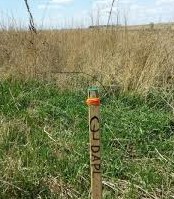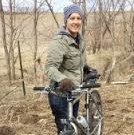Tuesday, March 17, 2015 – Reasnor, Iowa
{For the latest Iowa Pipeline Walk route and schedule detail, click here.}
The path of the pipeline tracks close to the Newton Correctional Facility, and my road leads me to the prison’s front gate. Like a tourist snapping his photo in front of the Eiffel Tower or Taj Mahal, I decide this is an opportune moment for a selfie. In the scant minute it takes me to position myself in front of the prison’s bright blue sign, a large security guard in a comparably large SUV races from the prison walls and pulls in front of me.
He demands to know who I am and what I am doing. He mumbles something about officials being nervous when people take pictures in front of the prison, about how those pictures could aid a prisoner plotting an escape. (I learn from a woman living near the prison that the last escape was 1953.) I ask if the pipeline would come through the prison’s grounds. He tells me “no,” his body language making it clear that the conversation is over and that I should move along.
I continue to walk, and think about another pipeline. One fashioned by government. One that now ships more people to prison than ever before. The U.S. prison population has risen 700% since 1970. With only 5% of the world’s population, our country houses 25% of the world’s prisoners! The number of inmates in Iowa prisons is on track to hit 10,000 in 2015, up from 2,700 in 1986.
Yes, I know there are violent people who belong in prison. In the mid-1990s, I lived behind a guy who killed two of my neighbors. When his rap sheet came to light after the crime, we couldn’t understand why he was not already locked away. But his ilk are a small percentage of those behind bars. The bulk are non-violent offenders, incarcerated in a criminal-justice system increasingly driven by fear, money and jobs.
My thoughts are interrupted by a pick-up truck driver slowing down in front of me. He’s wearing camouflage and a “Case IH” hat. He pulls over on the downwind side of the road, and gruffly inquires as to what I’m up to. When I explain, he goes on to extol the virtues of pipelines. He spouts an admittedly impressive string of pipeline facts, and laughs as he says, “I know a thing or two, don’t I. And that makes me dangerous.”
“I’m learning a thing or two every day,” I reply. “And when I’m done with this walk, I’ll be as dangerous as you!”
He got a kick out of that, and we both chuckled as a semi passed, sending a thick cloud of dust our way. The man rolled up his window. My only line of defense was to close my eyes and hold my breath as I felt a thick blanket of dust coat my face and hands. Four vehicles would pass during the course of our conversation.
When the dust from the semi settled, I shifted the talk from pipelines to climate change. I was not in a mood to pull any punches, not inclined to sugar-coat the message: “Scientists are emphatic that we’ve got a crisis on our hands. We’re at 400 parts per million of carbon in the atmosphere. Across the globe, we’re seeing the hottest years on record. Fossil fuels are the problem, and we’ve got a world of hurt coming our way.”
For the first time in our conversation, the man looked reflective, less “dangerous.” After a pause, he said, “Well, it doesn’t really matter because I’ll be dead by the time things get really bad.”
I felt an instant wave of sadness wash over me. “I’m not a grandfather yet,” I offered, “but I probably will be some day. And I want my grandkids and their kids to have a life worth living.”
I felt the man soften a bit further. He told me he had a grandson, age five. His voice trailed off. As I prepared to head down the road, I told him to send that grandkid my way when he gets a little older and he and I can work on saving the world together. “Nothing takes the sting out of despair like getting involved,” I concluded.
Such conversations are difficult. Disturbing. Regrettably frequent. Sometimes they roll off my back. This one settled on me like a layer of gravel-road dust. I couldn’t shake it, couldn’t wrap my mind around the “I’ll be dead so I don’t give a damn” attitude. Yet with this man, as with some of the other cynical types I had encountered over the past three weeks, there emerged in the end a smidgeon of compassion, an acknowledgement of concern for the future, for life beyond one’s own fence rows.
“You take care, Ed,” said the man, addressing me by name as I walked away. I took that as an indication that we had bonded just a bit – perhaps not over pipelines, but over grandchildren and dust.
The highlight of the day’s walk was meeting Vanessa Fixmer-Oraiz,a University of Iowa student who rolled her bike along while we walked and talked. Vanessa is conducting interviews as part of an oral history project on climate solidarity. After a couple miles, we sat out of the wind in the remains of a patch of trees that had been ripped and shredded in what appeared to be an aborted effort to forcibly remove them. I took the presumed failure of the machinery of arboreal death as a sign of hope.
A more solid sign of hope is the intelligence and optimism evident in Vanessa’s passion for life, nature and humanity – a refreshing contrast to the despair and resignation embodied in the heart of a cynical pick-up driver and in the walls of an imposing prison, whose stark slabs of concrete and miles of coiled razor wire would have made Josef Stalin proud.




